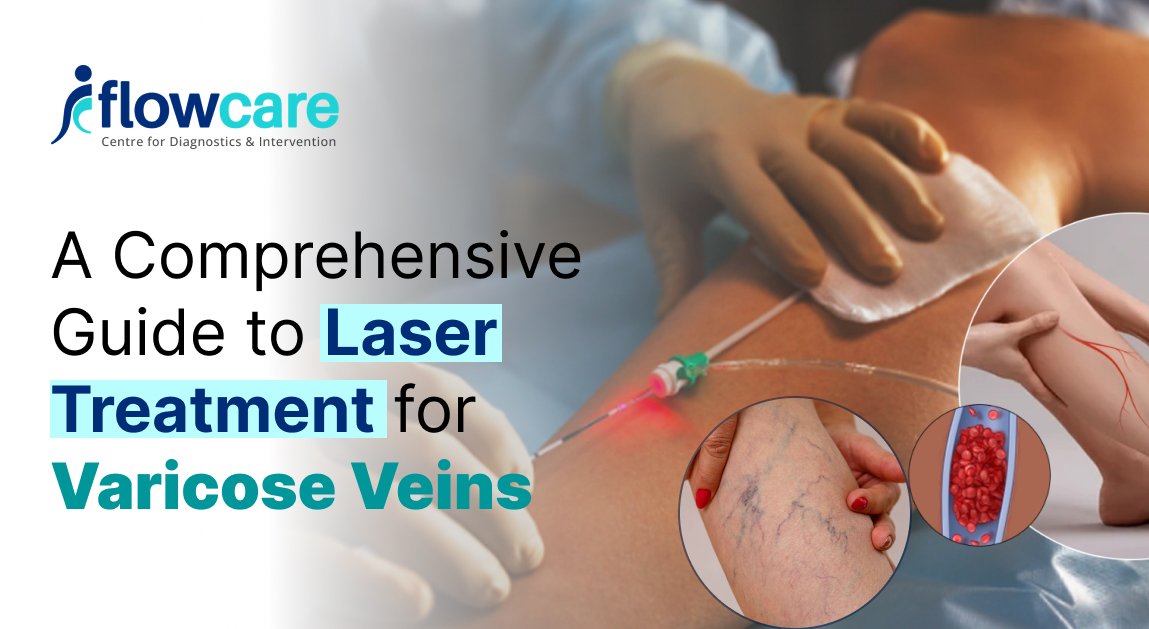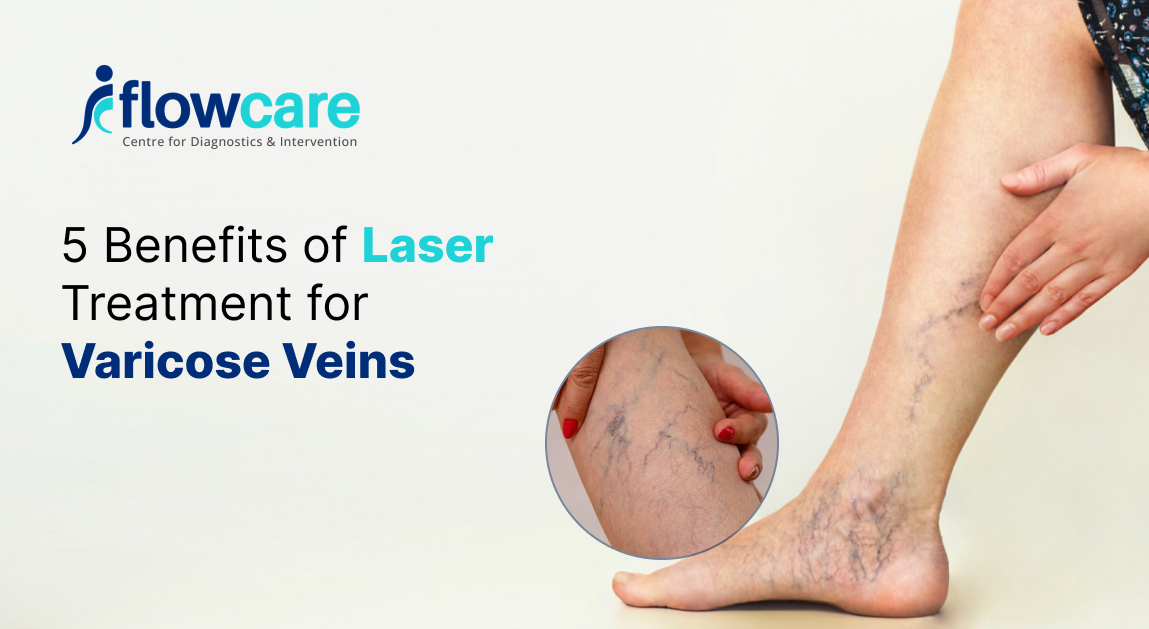
A Comprehensive Guide to Laser Treatment for Varicose Veins
Think Varicose veins only affect the elderly? It turns out that 33% of the 18- to 65-year age group has them(1).
However, the good news is that laser treatment offers a 95%-100%(2) success rate without invasive surgical treatment.
Read further to know more.
What are Varicose Veins?
Varicose veins are swollen, twisted, and enlarged, often visible just under the skin’s surface.
This happens due to the weakening of the vein walls and/or faulty valves that help blood flow back to the heart.
But when they fail, blood pools in the veins, increasing pressure. Over time, this causes the veins to swell, twist, and become visibly prominent under the skin.
Source: nhlbi(3)
Overview of Laser Treatment as a Solution
This section will explain the basics of laser treatment for varicose veins.
What is Laser Treatment?
Laser therapy is a modern, minimally invasive, ultrasound-guided procedure for treating varicose veins with laser energy.
In this case, doctors treat varicose veins without making a cut.
A phlebologist, interventional radiologist, or vascular surgeon usually administers it.
Unlike vein-stripping surgeries, laser treatments use high-intensity laser energy to close off and shrink the affected veins.
Laser Treatment Works for Varicose Veins: Mechanism of Action
The word LASER stands for Light Amplification by Stimulated Emission of Radiation. A commonly used laser for this procedure is Endovenous Laser Ablation (EVLA).
This treatment inserts a very thin fibre-optic laser into the problem vein. Once activated, the laser sends light energy to the tip, which spreads the heat around the inside of the vein.
This heat damages the vein wall, breaking its structure, especially the collagen. As a result, the vein shrinks, collapses, and eventually seals shut.
The doctor injects a special solution called tumescent anaesthesia around the vein before using the laser. This has three main purposes:
- It numbs the area, so the procedure is painless.
- It compresses the vein to make it easier to treat.
- It protects the surrounding tissues from heat damage.
Source: ncbi(4)
Complete Guide to Laser Treatment for Varicose Veins: From Consultation to Recovery
Pre-Treatment Consultation
These are the following steps:
- Discuss your full medical history, including any blood clots, bleeding issues, or medications.
- Share your symptoms and treatment expectations with the doctor.
- A Colour Doppler ultrasound is usually done to:
- Confirm vein reflux (backwards blood flow)
- Map the affected veins for accurate treatment planning
Physical Examination
Your doctor will first perform a physical examination of your legs to assess visible vein changes, skin texture, and areas of tenderness before recommending a Doppler ultrasound.
Pre-Procedure Instructions
The following are the pre-procedure instructions that your doctor might give, and should be followed:
- Don’t apply lotion or cream before the procedure
- Wear loose-fitting clothing
- Eat light if local anaesthesia is planned
- Stop certain medications if advised
- Arrange someone to accompany you (if needed)
Step-by-Step EVLA Procedure: What to Expect
Laser treatment for varicose veins is a minimally invasive, outpatient procedure, typically performed in a clinic setting.
General anaesthesia is not required; local tumescent anaesthesia is used to numb the area and protect surrounding tissues.
1. Getting Ready:
You’ll lie comfortably while the doctor cleans the treatment area.
Using an ultrasound machine, the doctor locates the affected vein.
A special fluid called tumescent anaesthesia is injected around the vein to numb the site, compress the vein, and shield nearby tissues from heat.
2. Inserting the Laser Fibre:
A tiny cut is made in the skin, and the laser fibre is gently inserted into the vein. Typically takes 15–45 minutes per limb.
3. Activating the Laser:
The laser is turned on and slowly pulled back through the vein. The heat seals the vein as the fibre is withdrawn.
4. Wrapping Up:
The fibre is removed once the vein is sealed, and a small bandage is placed over the site. You may be asked to wear compression stockings for a few days.
5. Quick Recovery:
The procedure is usually done in a clinic, not a hospital, and doesn’t require general anaesthesia.
Most people can go back to work within a day. Studies show that laser treatment offers a 95%-100%(5) success rate.
Post-Treatment Care
- Walk immediately after the procedure (30–60 minutes recommended)
- Compression stockings must be worn as advised for a few days to weeks.
- Resume normal activities in 1–2 days.
- Avoid heavy lifting or strenuous activity for 1–2 weeks.
- Mild pain, bruising, or swelling is common and manageable with medication.
- Protect treated areas from sun exposure for a few weeks.
- Watch for complications like:
- Sudden leg swelling or pain
- Redness, fever, or warmth in the leg
- These may indicate infection or blood clots. Contact your doctor promptly.
- Follow-up appointments are important to monitor healing and success.
Follow-up
Your first follow-up ultrasound is usually done 1 week post-procedure to ensure the vein is closed.
A second visit may be scheduled around 4–6 weeks to monitor healing and outcomes.
What are the Benefits of Laser Treatment for VVs?
The following are the top benefits of laser treatment for varicose veins:
- Laser Ablation is Minimally Invasive
- Offers Quick Recovery
- Laser has a higher success rate compared to other related treatments
- The procedure’s small incisions lead to minimal scarring
- Reduced Risk of Complications
- Offers Cosmetic Improvement
Devices Used in Varicose Vein Treatment
Various kinds of devices are used in VV’s treatment. Read below to know more.
- Endovenous Ablation
- Catheters: Thin tubes inserted into the veins to deliver heat.
- Laser Fibres and Radiofrequency Electrodes: These are thin wires that carry energy.
- VenaSeal: It’s a system that uses medical glue to glue the vein shut.
- Other Devices
- Ultrasound Machines: These visualise the veins during procedures like endovenous ablation to guide the catheter placement.
- Compression stockings: While not a device used during procedures, compression stockings are often recommended after treatment and can be used alone for milder cases.
- Surgical instruments: Various surgical tools tie off (ligate) and remove the veins.
What is the Varicose Veins Laser Treatment Price?
At FlowCare, the price for laser treatment (Endovenous Laser Ablation) is approximately ₹50,000 per limb.
This includes using advanced medical devices, ultrasound guidance, and professional fees.
The cost can vary based on factors like the severity of the condition, the clinic’s location, and whether one or both legs need treatment.
Although this can be considered a considerable investment, EVLA provides long-term relief, low downtime, and 95%(6) even five years post-procedure.
In this manner, it is an economically viable medication instead of recurrent conservative treatment.
Who is an Ideal Candidate for Varicose Veins Laser Treatment?
Laser treatment, like Endovenous Laser Ablation (EVLA), is best suited for:
- Patients with visible, painful, or swollen varicose veins
- Confirmed vein reflux on a Doppler scan
- Those who want a minimally invasive, fast-recovery option
- People who haven’t responded to conservative treatments like stockings
- Patients with cosmetic concerns
Age & Health Considerations:
- Young to middle-aged adults: Ideal if symptoms are early or moderate
- Older adults: Still eligible if overall health is stable
- Diabetic or heart patients can benefit from proper monitoring.
- Not suitable for: Pregnant women, those with active infections or blood clots
Who Should Avoid Laser Treatment?
Laser treatment (EVLA) is not suitable for everyone. Patients may be advised to avoid the procedure in the following cases:
- Active deep vein thrombosis (DVT)
- Severe peripheral artery disease (PAD)
- Active skin infection or open wounds near the treatment area
- Uncontrolled bleeding disorders
- Pregnancy (treatment is usually postponed)
- Inability to walk post-procedure (walking is essential for recovery)
- Severe obesity that prevents proper ultrasound guidance
Always consult a vascular specialist to determine if laser treatment suits you.
What is the Recovery Time After the Treatment?
Post-treatment, patients can return home on the same day. Full recovery takes between 1 and 2 weeks.
In addition, doctors encourage patients to walk for 30–60 minutes to promote circulation.
Patients can resume normal daily activities within a few days. Mild pain or swelling may occur, but is manageable with pain relievers and ice packs.
Wearing compression stockings as prescribed is essential for proper healing.
Patients should avoid strenuous activities, heavy lifting, and prolonged standing during recovery.
Sun protection is also advised, as the skin may be more sensitive during this period.
What is Varicose Veins Stage-1 Management?
Treatment may begin with conservative options like compression stockings and lifestyle changes for patients in the early stages of the condition, such as varicose veins stage 1.
However, minimally invasive treatments like EVLA offer effective and long-lasting relief if symptoms progress or the veins worsen.
Conclusion
Laser treatment of varicose veins has also become a gold standard option due to its effectiveness and low intervention.
Patients with Endovenous Laser Ablation (EVLA), when the procedure has high success rate, quicker recovery, less scarring, and have a long term outcome, do not require traditional surgery.
Due to the progress in medical equipment for varicose veins, laser treatment is more accurate today, safer than before, and more available.
You should never decide about EVLA on your own. Your vascular specialist is the right person to consult on whether EVLA suits you.
And the earlier you have the varicose veins treated, the better your overall living standard will be, not only your legs but also your overall living standard.
FAQs
Is laser treatment safe for varicose veins?
Yes, laser treatment for varicose veins, especially EVLA, is considered safe when performed by a trained specialist.
It is minimally invasive, uses local anaesthesia, and has a low risk of complications.
How effective is laser treatment for varicose veins?
Laser treatment has a success rate of 95–100%, especially when Doppler-guided and performed by an experienced practitioner.
Most treated veins remain closed even after 3 to 5 years.
What is the recovery time after laser treatment?
Most patients return to daily activities within 1–2 days. Full recovery typically takes 1 to 2 weeks.
You’ll be advised to wear compression stockings and avoid strenuous activity during this period.
What is the cost of laser treatment for varicose veins?
At clinics like FlowCare, the varicose veins treatment cost is approximately ₹50,000 per limb.
This may vary depending on your condition, clinic location, and whether one or both legs are treated.
Am I a good candidate for laser treatment?
You may be a good candidate if you have visible, painful, or swollen varicose veins, confirmed vein reflux on Doppler ultrasound, and are in overall good health.
Pregnant women, patients with DVT, or those with active infections may not be eligible.
Does laser treatment leave scars?
No, laser treatment involves only a small puncture site and typically results in minimal to no scarring, unlike traditional vein stripping surgery.





